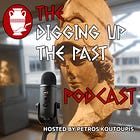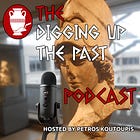Featured Episode - In Search of Lost Egyptian Tombs
Issue 54
In This Episode
In this episode, we sit down with Egyptologist, Dr. Chris Naunton, to discuss his book, Searching for the Lost Tombs of Egypt. What has the archaeological evidence revealed to identify the final resting places of important historical figures such as Imhotep, Alexander the Great, Cleopatra, and more? We also talk about Egyptology as a whole, the Pharaoh Tutankhamun, the end of the New Kingdom and Late Intermediate Period, and more.
You can listen to this episode on:
Video Teaser: In Search of Lost Egyptian Tombs
To watch the full video of Episode 23 with bonus materials, subscribe to the Ancient Origins Premium site or to the Ancient Origins UNLEASHED Substack.
To watch the full video of Episode 23 with bonus materials, subscribe to the Ancient Origins Premium site or to the Ancient Origins UNLEASHED Substack.
Glossary
Alexander the Great - (356 - 323 BC) Alexander III of Macedon was the son of Philip II, and led a campaign from Greece all the way to Asia, conquering the known world and creating the Macedonian empire.
Bronze Age - Defines a historic period dated to approximately between 3300 BCE and 1200 BC. It is characterized by the use of bronze, the presence of writing in some areas, and other early features of urban civilization.
Cleopatra - (70 - 30 BC) Cleopatra VII Thea Philopator was Queen of the Ptolemaic Kingdom of Egypt and its last active ruler.
Herihor - An Egyptian High Priest of Amun at Thebes (1080 - 1074 BC) during the reign of Pharaoh Ramesses XI.
Homer - An ancient Greek poet, living in the late 8th or early 7th centuries BCE. He is credited for authoring both the Iliad and the Odyssey.
Hyksos - The Hyksos was an ethnic identity for foreign rulers (likely of Semitic origin) who migrated into the Egyptian Delta region and ruled Lower Egypt for the century that defined the Second Intermediate Period (c. 1650 - 1550 BCE) and just before the New Kingdom Period.
Imhotep - (late 27th century BC) An Egyptian chancellor to the Pharaoh Djoser, architect of Djoser's step pyramid, and high priest of the sun god Ra at Heliopolis.
Iron Age - Defines a historic period which started at approximately between 1200 BCE in the eastern Mediterranean. It is characterized by the use of iron and the appearance of new civilizations.
Late Bronze Age - A historical period defining the end of the Bronze Age in the Eastern Mediterranean that began at c. 1500 BCE and ended c. 1200 BCE.
Manetho - An Egyptian priest from Sebennytos who lived in the Ptolemaic Kingdom in the early third century BC, during the Hellenistic period.
Mark Antony - Marcus Antonius (83 - 30 BC) was a Roman politician and general. He was one of many players responsible for transforming the Roman Republic into the Roman Empire.
Osorkon III - Pharaoh of Egypt in the 8th Century BC.
Psusennes I - Third pharaoh of the 21st Dynasty who ruled from Tanis 1047 - 1001 BC.
Shoshenq II - Pharaoh of the Twenty-second Dynasty of Egypt.
Recommended Books
Searching for the Lost Tombs of Egypt
By Chris Naunton
Where are the tombs of Alexander the Great or Cleopatra? Both rulers were buried in Egypt, but their tombs have never been found despite years of intensive research and excavation. Yet we have tantalizing clues. Searching for the Lost Tombs of Egypt describes the quest for these and other great "missing" tombs―those we know existed, but which have not yet been identified. It also discusses key moments of discovery that have yielded astonishing finds and created the archetypal image of the archaeologist poised at the threshold of a tomb left untouched for millennia.
In this gripping account, Chris Naunton explains the mysteries of the missing tombs and presents all the evidence, skillfully unraveling the tangled threads surrounding the burials of the heretic pharaoh Akhenaten and his son Tutankhamun, and the burial place of Imhotep, architect of the Step Pyramid at Saqqara, among others. Could other such tombs lie undiscovered in the Valley of the Kings? In fact, the Valley almost certainly does guard hidden treasures. Amazing finds of unsuspected tombs continue to occur there and elsewhere in Egypt, making headlines worldwide―all are covered in this book.
As well as immersing the reader, step by step, in the action of the search and the thrill of discovery, the book also explores the reasons why tombs remain such a central part of both the popular perception of Egyptology and the continuing allure of ancient Egypt.








